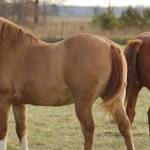Tail Hair Growth in Horses

Horses and ponies with long, sweeping tails have a far greater ability to whisk away pesky insects than peers with thin, wispy, or short tails. While some horses end up with bristly, stubby tails through circumstance—a chew-happy pasturemate comes to mind—other horses, such as those belonging to certain breeds such as Appaloosas and some drafts, simply don’t produce long tail hairs.
How fast do equine tail hairs grow? The answer depends on diet, season, breed, and the characteristics of each individual horse.
Austrian scientists from the University of Veterinary Medicine in Vienna measured tail hair growth rates in three groups of equines: Mongolian wild asses, Przewalski’s horses, and domestic horses. Both wild species as well as free-ranging domestic horses shared the same habitat in the Gobi Desert in Mongolia, a challenging environment that offers sparse grazing and few sources of water.
In this study, tail hairs took 19 days to lengthen by one centimeter for wild asses. Przewalski’s horses grew one centimeter of tail hair in 17 days, while domestic horses produced the same growth in 13 days. Growth rates were variable among the animals in each group, and each figure is an average for several equines. Horses that live in more hospitable climates might show growth rates that differ significantly from these numbers.
Growing long tails takes time, and owners can support the development of a luxurious tail by providing balanced overall nutrition to their horses. Dietary supplements like Bio-Bloom PS from Kentucky Equine Research (available in Australia as Bio-Bloom) provide zinc, iodine, biotin, and methionine, nutrients minerals horses need to produce shiny coats, healthy hooves, and mane and tail hair.








